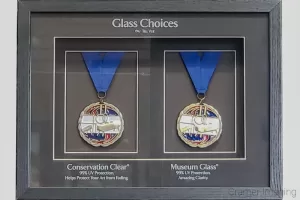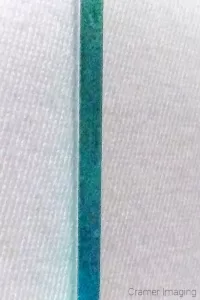
When you buy fine art photography, you can choose from several options of glazing: the glass in front of the picture designed to protect it from harm. Now oil paintings often don’t get a glazing. Photography, on the other hand, along with other forms of fine art paintings like watercolor, usually does get a glazing in front. Why is this? That is what we’re discussing here today: regular vs acrylic glass.

The glass is for protection of the fine art and, while glass in front would certainly help protect an oil painting from damage, please keep in mind that most oil paintings can take years to fully dry. If you place glass in direct contact with the painting prematurely, it can and will damage the artwork it is meant to protect.
Oil paint is also thick and textured when applied meaning you have to find a way to space the glass away from the surface of the artwork. Fine art giclée prints are very flat and can be kept from contacting the glass with a simple piece of mat-board, which is usually part of the framing process.
There are huge number of options for glazings including UV protection, anti-glare and the like, but for this article we’re going to discuss the material. This means we have a choice between to mineral (basically regular) glass of various qualities and acrylic or plastic of various qualities.
As with everything else, what kind of glazing (regular vs. acrylic glass) you should choose depends on your wants, needs and budget.

Cheaper glass, like you get what you get with a cheap picture frame, has a slight green tint to it. You can see it very well when looking at the edge of a large piece. The glass looks green instead of clear. This is due to ferrous oxide in the glass.
For glass 1/16th to 1/8th of an inch thick, this green tint will be difficult or impossible to see when looking directly through the glass, but some choose to go with a clearer and more expensive museum quality glass. Acrylic plastics for glazing on the other hand are usually already nicely clear.
Cheap glass is likely more cost-effective than plexi-glass. High quality museum glass is likely going to be more expensive than plexi-glass. The raw cost of the glass vs. acrylic probably isn’t a good deciding factor as there just isn’t that much difference. Other factors are going to make far more difference in what you choose to use.
 First let’s evaluate regular vs. acrylic glass based on solely how each looks over top of the art.
First let’s evaluate regular vs. acrylic glass based on solely how each looks over top of the art.
Acrylic is a bit more clear, and this gets very pronounced in things like large windows or fish tanks where the glass gets very thick. For art glazing, which is rather thin, the difference isn’t particularly visible, but again some people may be able to see it. There will be less to interfere with viewing your art if you go with acrylic.
On the other side of the coin, a lot of people say that the acrylic looks like plastic, and isn’t as aesthetically pleasing. Plastic has a cheap look and feel which many people feel seems to cheapen the fine art.
Glass on the other hand looks like glass. It has an ageless and natural look and feel that will go well with art of any type.
Now as to the specific properties of each, let’s start some of the downsides of glass.
Glass is a lot heavier than acrylic is. This means that if you are glazing a large image, you have to take the weight of the glass into account when choosing a frame and frame mount. If you go with glass for a very large print, you may find that you can’t use some narrower frames and you are not able to mount your image in exactly the place you want because the drywall isn’t strong enough. Because of the glass weight, you must mount your picture frame to a stud which might not be right where you want your picture displayed.
Of course the weight of glass affects any shipping cost you might incur. If the framed art must be shipped, glass is going to be a lot more expensive to ship. Any money you may save by choosing a cheaper glass option will be eaten up in increased shipping costs unless the frame is small.
The weight issue can be ameliorated by going with thinner glass but choosing thinner glass exacerbates our next problem.

Glass is also more prone to breaking than acrylic is. A broken pane of glass in a fine art frame will almost certainly damage the print. How likely is it that the glass will be broken? Will the print hang in a high traffic area where someone may accidentally bump into it causing it to fall? Will children be pretending the floor is lava and hopping around on the furniture?
Not only will the added weight cost significantly more money for shipping, breakage from rough handling is always a major concern. The concern worsens near the holidays when most shippers are overloaded. Some people even claim with only a shade of sarcasm that most major shippers can find ways to break things that even the U.S. Army can’t. Also be aware that many shippers do whatever they can to not pay out on damage claims even when they pack the item.
Of course, glass isn’t the only thing with a downside. Acrylic has it’s own set of trade-offs.
Acrylic is more prone to static, meaning it attracts dust much like an old style television screen. The static charge can also cause problems with media like pastels or charcoal. Dust dulls the brightness of the image distorts the sharpness slightly. You will need to clean your fine art photography print far more often. This leads us to its next major problem.

Another problem you face in choosing between acrylic and glass is the problem of scratching the surface and distorting the image behind.
While it is far less breakable, acrylic is far more prone to scratching and can be scratched easily by paper towels even with the most delicate of touch. You should clean it using microfiber cloths only. Glass can be wiped off with a paper towel and it won’t scratch as glass is quite hard. Also be careful in choosing cleaning chemicals to use on acrylic. You can easily use ammonia cleaners on glass with no issues.
If mommy’s little helper takes a paper towel and wipes the dust or other grime off the plexi, it will have small scratches in it. The first time, they will most likely be too small to see, but if it keeps happening, the scratches can become quite pronounced. This leads to unpleasant distortion of the image behind the acrylic glass.
While it’s less of a concern for fine art glazings, you should note that acrylic will also yellow over time particularly with ultraviolet light exposure. If the artwork is inside and on a wall, it will be less of a concern, but still will likely yellow over decades. This will distort the color of your fine art photo over time though you will likely not see the results yourself.

As discussed above, when choosing the proper glazing for your fine art photography, you have several different aspects to consider. This chart sums up the article above if you need a quick cheat sheet. Use it to help you choose between regular vs. acrylic glass.
| Glass | Acrylic | |
| Pros |
|
|
| Cons |
|
|
Whether you choose regular or acrylic glass will depend greatly on your needs and on who is providing the artwork for you. Some suppliers only provide one or the other. Others will provide whatever you ask for if you pay for it.
I prefer the look and feel of glass along with the simplicity of cleaning. However since we tend to have the framing done locally rather than framed and then shipped, the additional cost of shipping the heaver glass isn’t a concern. Children playing rough in the house is also not currently a concern so most of the downsides to glass don’t matter to us.
If I were shipping the artwork, had young children, or were going to be moving a lot in the future, I would probably look far harder at acrylic as it is a bit more resistant to rough handling.


Receive monthly updates in your inbox from us.

Join our email-only photo of the week club to get the full stories behind how we captured our favorite fine art landscape photos.
We respect your privacy
No More Results